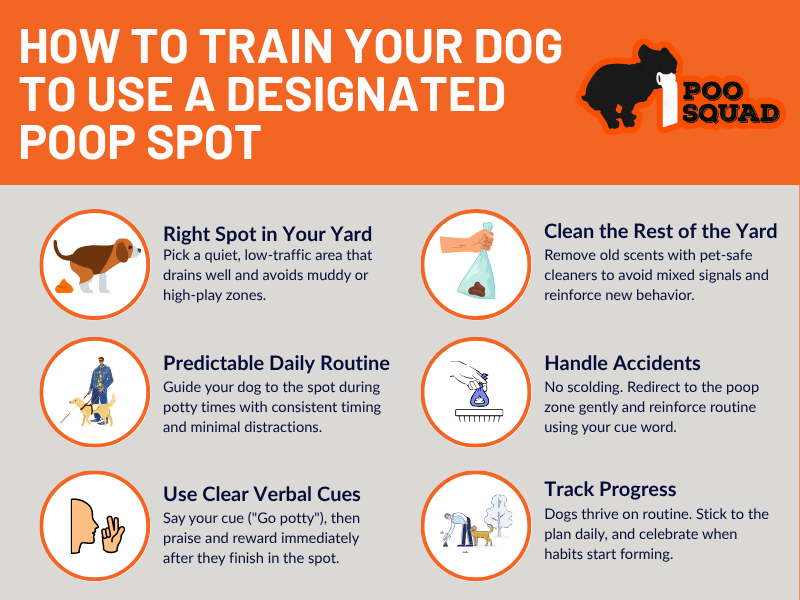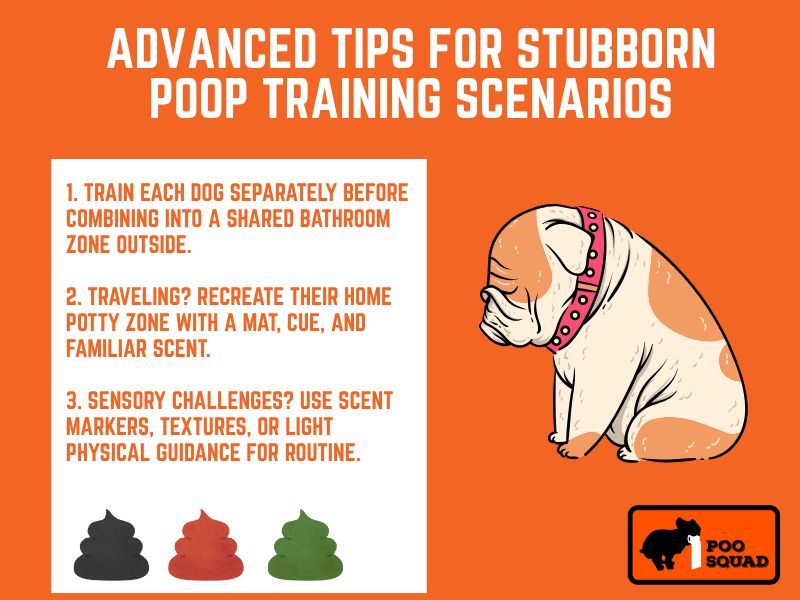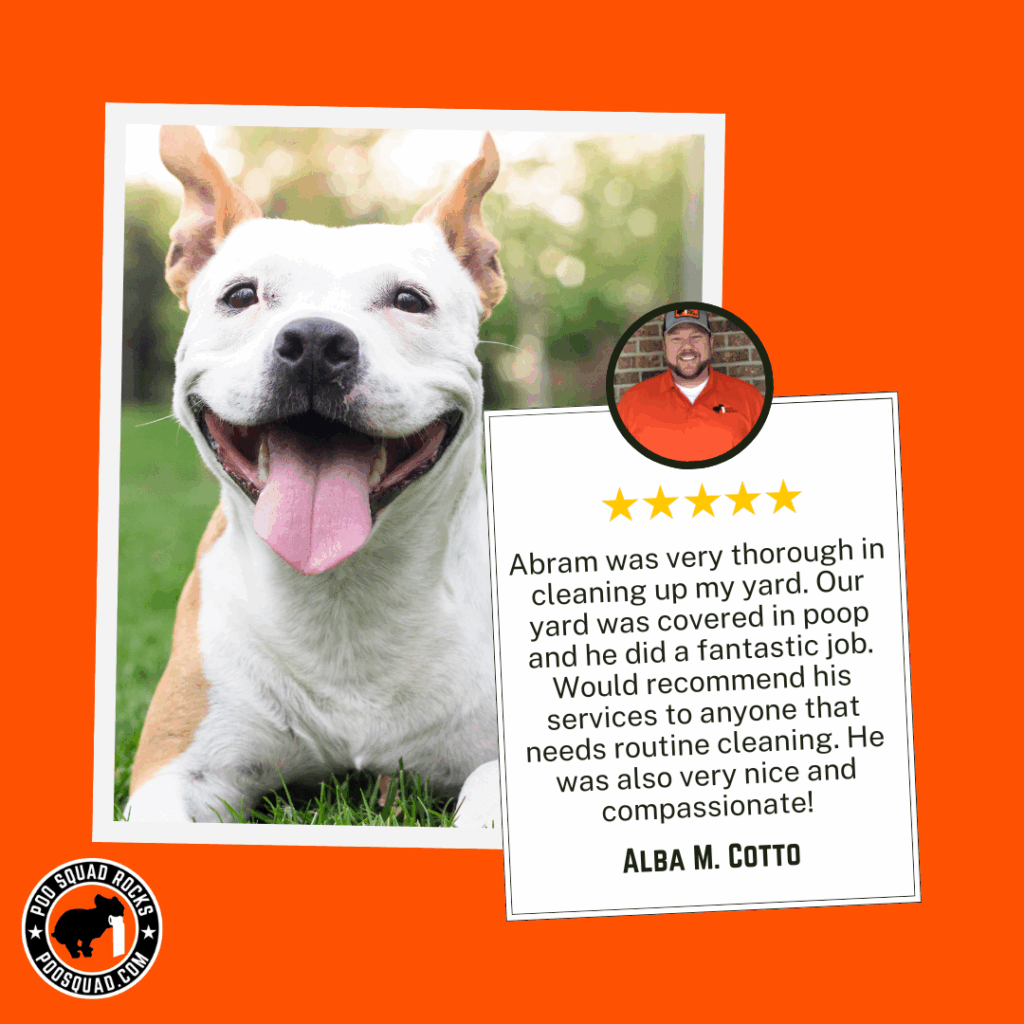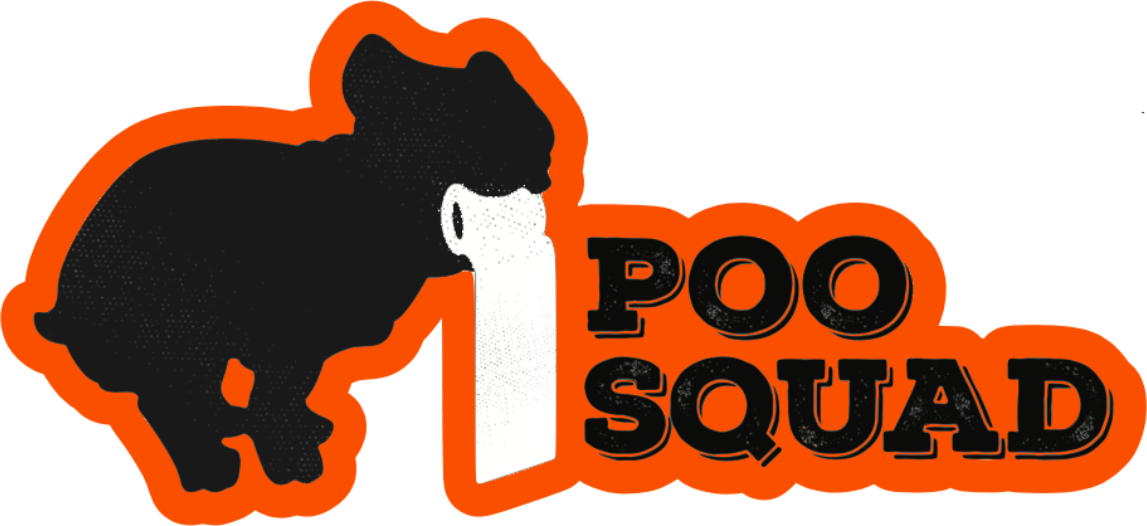How to Train Your Dog to Poop in One Yard Spot?
Train your dog to poop in one yard spot by guiding them to the same area after meals or naps, using a consistent cue, and rewarding them immediately. Choose a dry, low-traffic location that’s easy to clean and separate from play zones.
Training your dog to poop in one designated area of the yard gives you back control, no more random piles, ruined grass, or cleanup guesswork. This approach keeps your outdoor space cleaner, protects your lawn, and makes scooping faster and less frequent.
The key is structure. Dogs thrive on routine, and with a clear cue, a consistent schedule, and a little patience, most pups learn to use a single bathroom zone within days. This method is not only for new puppies; it works for rescues, older dogs, and even multi-dog households.
Here is how to pick the right spot, how to train using timing and reward, and how to fix common issues like marking elsewhere or holding it in. You’ll also get extra help with small yard layouts, sensory-challenged dogs, and tools that keep the process clean and stress-free.
If it ever feels like too much, our residential dog poop cleanup service can step in to support your progress and keep your yard fresh during training. Let’s get started, because your lawn should be a space you enjoy, not tiptoe through.
Why Designating a Poop Spot Helps Everyone
Designating a single bathroom spot in your yard is not about being picky; it’s about making life easier for you, your family, and your dog. It cuts down your cleanup time, protects your lawn, and creates a healthier space for everyone who shares that backyard.
When your dog uses the same area every time, you avoid accidental barefoot discoveries and eliminate random lawn stains caused by over-soiled grass. It’s also easier to keep your outdoor space sanitized, especially when you include occasional deodorizing treatments to control lingering smells.
Families with kids especially benefit from separating the poop zone from play areas. For families who want to maintain a healthy outdoor environment, this dog poop yard management guide offers extra strategies on spacing, frequency, and sanitation.
Plus, if you ever host guests or let the dogs run loose during gatherings, having that “bathroom zone” clearly established reduces awkward moments and cleanup chaos.
We’ve even seen this simple shift cut down arguments between spouses, because let’s face it, no one wants to be the default scooper every Saturday morning.

We’ve helped countless homeowners make this transition, and the payoff is huge: less time scooping, fewer surprises, and a cleaner, happier home environment for everyone.
Step 1 – Choose the Right Poop Spot in Your Yard
Before you can train your dog to poop in one area, you need to pick a location that sets both of you up for success. Think of this spot as your dog’s restroom, a place they’ll return to day after day. Location does make or break the habit.
Pick a Low-Traffic, Consistent Location
Choose a corner of the yard that’s away from patios, play zones, and footpaths. The area should be quiet and distraction-free. Dogs tend to feel vulnerable while pooping, so giving them a private nook helps them settle in. If your dog already favors a certain spot, lean into that habit; no need to fight instinct if it’s working in your favor.
Avoid Muddy or Wet Areas
A soggy, muddy yard is not fun for anyone, especially not for your dog’s paws or your clean floors. Pick a space that drains well and stays dry after rain. If your yard tends to hold moisture, consider using mulch or pea gravel in that zone to keep it more appealing.
Make It Easy to Clean
Design the area with cleanup in mind. Some homeowners even add a small border or temporary fence to mark the poop zone and make waste pickup more manageable. And when things get out of hand (like they sometimes do), our yard sanitizing service can bring things back to fresh in no time.
Have a Small Yard? No Problem.
Even in tight outdoor spaces, you can still create a designated poop spot. Use visual markers like planters or stones to define the area. Keep it clean and don’t let it become overloaded. One concern we hear from families with smaller yards is whether this setup will ruin their grass. The answer? Not if you manage it consistently and use the right sanitation techniques.
Step 2 – Set the Habit with Structure & Routine
Once you’ve chosen the right spot, it’s all about building consistency. Dogs are creatures of habit, and a reliable routine paired with the right cues helps them learn faster. This part takes a little patience, but the long-term payoff, less mess and more control, is worth it.
Time It Right
The best time to guide your dog to the poop zone is when they’re naturally ready to go:
- First thing in the morning
- After meals
- After naps or playtime
- Right before bedtime
Grab a leash, head straight to the poop zone, and stay there until your dog finishes the job. Avoid letting them roam freely before they’ve gone; it only adds distractions and delays.
Use a Consistent Cue
Pick a phrase like “Go potty” or “Do your business” and say it each time you bring them to the spot. Dogs associate words with actions through repetition. Be consistent, calm, and positive with your tone.
If your dog is unsure, leaving one poop pile in the area can help reinforce the scent. Clean the rest of the yard thoroughly to prevent confusion. If that sounds like a chore, our residential scooping service can keep the yard fresh while you’re focused on training.
Create a Simple Schedule
Your dog’s internal clock will sync with your consistency. You don’t need to overthink it, only commit to taking them to the same spot at the same time each day. You can even set reminders on your phone or jot it down next to the family calendar.
Older Dogs? Rescue Dogs? No Problem.
We hear this all the time: “My rescue dog was used to free-roaming. Can they learn this?” Absolutely. It might take a little longer, but older or adopted dogs can still develop new habits with structure and praise. Stick to the basics, and you’ll see results.
Step 3 – Reinforce the Right Behavior
Dogs don’t respond to guesswork; they respond to timing. When they get it right, you need to reward them immediately so they associate the praise with the act. Reinforcement is where the real training happens. This step is simple but crucial to making the habit stick long-term.
Praise and Reward Immediately
As soon as your dog finishes doing their business in the designated spot, give verbal praise and offer a small treat within two seconds. Timing matters. If you wait too long, they won’t connect the reward with the action. Your excitement will help them understand that they did something good.
Turn Play Into a Reward
Letting your dog play after a successful poop session reinforces the idea that good things happen when they follow the routine. But don’t flip it, don’t let them play before they go. Play should be a reward, not a distraction. The moment they realize poop leads to play, you’ve got leverage.
Watch the Pattern
Some families like to track progress in a small notebook or app. If that’s your thing, great. If not, you’ll still start to notice your dog pooping quicker and more confidently in the right spot after a week or two. The payoff is real: no more hunting piles across the yard.
Visible Reinforcement Helps
We show up in bright orange uniforms and branded trucks, so dogs recognize us and the job we’re there to do. That consistency helps them feel safe and confident in their environment, just like a structured poop routine does at home. If you’re struggling to keep up, we can help with recurring poop scooping and deodorizing so your dog’s space stays clean and inviting.
Step 4 – Prevent & Redirect Accidents
Even with great progress, accidents happen, especially early on. The key is to stay calm and redirect your dog the right way. Your job is not to scold, but to guide. A few smart cleanup strategies and consistent redirection will get you back on track without breaking your dog’s trust.
Clean Other Yard Areas Thoroughly
Dogs rely on scent. If they’ve pooped in multiple places before, those areas still smell like “permission granted.” To reset the yard, clean those spots as soon as possible using pet-safe deodorizing sprays or professional sanitation services that neutralize odor and bacteria. This step is essential for reprogramming your dog’s sense of where to go.
Avoid Harsh Corrections
If your dog has an accident, calmly guide them to the designated spot and use your verbal cue. Don’t yell, and don’t punish them after the fact; they won’t understand what they’re being corrected for. Positive repetition is more effective than negativity every time.
Help for Hesitant or Stubborn Dogs
Some dogs freeze up or hold it in when they feel pressure. If your dog seems nervous or stubborn, try using a longer leash so they don’t feel boxed in. And if they continue to resist, go back to basics: leash, cue, reward. We’ve seen this work even with the most independent pups.
Advanced Tips for Stubborn Scenarios
Some dogs are more challenging than others. Whether you’re juggling multiple pets, training while traveling, or managing unique behavior issues, these advanced tips will help you troubleshoot the trickier stuff and reinforce the progress you’ve already made.

Training in a Multi-Dog Household
If you’ve got two or more dogs, don’t try to train them as a pack right away. Work with each dog individually until the behavior is locked in. Later, you can merge them into a shared poop zone if they’re compatible. If one dog consistently misses the mark, revisit their solo training until they’re on board.
Keeping the Routine During Travel
Dogs thrive on routine. If you’re visiting friends, staying at a rental, or heading to grandma’s, try to replicate their home potty spot as closely as possible. Bring a few familiar items, like a mat or patch of turf with your dog’s scent, and use the same command. It helps your dog feel grounded, even in new surroundings.
What About Health Issues?
We’ve seen it all, from “poocassos” who decorate the yard with crayon-filled chaos to “pudding pups” dealing with chronic stomach issues. For dogs with health-related accidents, poop spot training may take longer and require more frequent cleaning. A consistent cleanup partner like our residential pooper scooper service can lighten the load so you can focus on your pup’s needs.
Blind or Deaf Dogs Can Be Trained Too
For dogs with sensory challenges, use tactile or scent cues. Lay down textured mats, place scent markers, or use gentle physical guidance. Over time, they’ll learn to associate that space with their routine, like any other dog.
Tools and Services That Can Help

Sometimes the right gear, or the right help, can make all the difference. If your dog is struggling to adjust, or if your schedule’s already maxed out, here are a few proven tools and services that can speed up the process and keep your yard looking like a yard.
Temporary Fencing or Markers
Adding a small fence or visual markers like garden stones can give your dog a clear physical boundary. This is especially helpful in open yards or multi-use spaces where the dog might otherwise wander. Think of it like training wheels; they’re not forever, but they help build consistency early on.
Professional Cleanup Services
When your yard gets overloaded or you miss a few days (we get it), a quick visit from our team can help reset the space. Our scooping and sanitizing services keep your dog’s designated area clean, odor-free, and ready for training.
Bright Uniforms and Trusted Staff
We wear bright orange for a reason. Dogs and people feel safer and more confident when they know exactly who’s entering their yard. We also send a photo of your closed and latched gate after each visit, giving you peace of mind when your dog heads outside again.
Recurring Service Plans
If you’re serious about maintaining a clean, consistent yard, a recurring residential pooper scooper plan ensures your dog’s routine stays intact without you having to chase down poop piles. We show up, clean up, and help keep the behavior on track week after week.
Keep It Consistent and Positive
Training your dog to poop in one spot is not magic; it’s a routine. With consistency, clear cues, and a little patience, most dogs learn faster than expected. You don’t have to be perfect. You only have to be persistent. Small wins add up, and your lawn (and shoes) will thank you.
No matter how messy the starting point, you can turn chaos into control. And if the process feels overwhelming, or if you simply want to fast-track your results, our residential dog poop pickup services are here to help. We’ll keep the yard clean, so you can focus on the bond, not the mess.
Ready to reclaim your space and make dog ownership a little bit easier? We’ve got your back.
Common Questions (Answered)
Once you start building a consistent poop routine, new questions tend to pop up. You’re not alone. These are the things our team hears all the time, from busy parents to first-time dog owners, so we’re breaking them down with honest, practical answers based on real experience.
Can puppies and adult dogs share the same poop spot?
Yes, but train them separately at first. Puppies need more structure and supervision, while older dogs might already have habits in place. Once both are consistent, you can merge their routines into a shared area.
What if my dog eats their poop? Will this make it worse?
If your dog tends to snack on their waste, it’s a behavior worth understanding. There are several reasons behind it, from nutritional gaps to attention-seeking. This guide breaks it down clearly and offers practical solutions.
How do I train a blind or deaf dog to use one area?
Use scent-based or tactile cues. Lay down a textured surface like a mat or mulch to create a distinct feel under their paws. Routine and patience are your biggest tools. Many dogs with disabilities adapt quickly when the environment is consistent.
Is it safe to have a poop zone near where my kids play?
Yes, if it’s managed properly. Keep the zones separated and clean. Many of our customers use landscaping features like bushes, stone borders, or temporary fencing to divide the yard. We also recommend regular sanitization to ensure a safe environment for everyone.
How do I avoid lawn damage in the designated spot?
Pick a well-drained area and don’t let waste build up. Rotate slightly within the zone if needed, and use pet-safe deodorizers to keep the grass healthier. If lawn care is a concern, our professional team can help you manage cleanup and odor with less stress.
Author: Chief Scooper
Jamie Coones is the founder of Poo Squad. He started the original location in Manhattan, KS in 2017 and has since licensed the brand to another 20 other owners with locations across the country.
